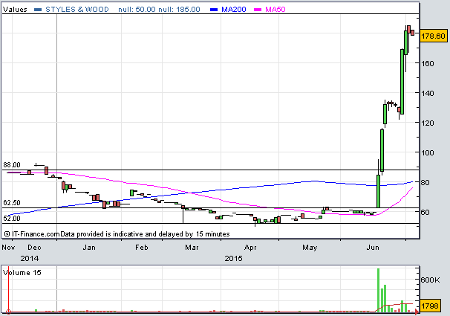Styles & Wood nursed back to health
3rd July 2015 11:01
What a difference two weeks make. A tidal wave of confidence has been injected into after the store and office fit-out firm secured a crucial injection of institutional cash and returned to growth. A City representative has just joined the board, underpinning the investment case. The firm is still tiny, but its share price has soared 200% to 184p since, so deserves further investigation.
Joining as non-executive director, Matt Widdall's appointment certainly went down well in the Square Mile. As part of Styles' refinancing, Business Growth Fund - set up by the UK's five biggest banks in 2011- bought a 25% stake in the firm, subject to its representative joining the board. Henderson Global Investors also increased its stake to almost 26%, with the right to nominate an advisor.
The pair bought outstanding convertible preference shares of £13 million nominal value from for £5.8 million, plus the bank's 17.2% equity stake for 50p a share - every year the preference shares cost Styles over £800,000 in notional interest charges plus cash dividend of £427,000. That's a huge burden for a company until recently capitalised at just £3.5 million.
A conversion price of 937.5p per share represents a 1,476% premium to the previous close price (18 June). A £2 million loan note with coupon of 10% per annum was also issued to redeem outstanding convertible preference shares of the same value. This leaves £5.8 million of convertible prefs outstanding.
Strengthening its balance sheet and blue-chip backing will help Styles reduce net debt from £11.8 million at the end of 2014 to £2.7 million by the end of December. This debt could be completely wiped out by the end of the 2016 financial year, reckons house broker Shore Capital.
By converting preference shares into conversion shares, net assets have increased by around £3.6 million and future cash interest outflows have been reduced by £5.2 million. This puts Styles in a better position to continue its diversification programme and take advantage of any acquisitive growth opportunities that crop up.

(click to enlarge)
Streamlining
Over the last two years, Styles has been disposing of its underperforming businesses, which has left it focused on the commercial fit-out, public sector and renewable sectors, in addition to its traditional retail and financial services.
"This strategic shift promises to deliver greater margin stability with much reduced cyclical exposure," says Robin Speakman at Shore Cap. "We believe a higher quality business is emerging."
Streamlining has paid off, with the group swinging back into growth last year. Revenue was up 3.2% at £97 million and improving gross margin tripled underlying pre-tax profit to £2.1 million. Earnings per share jumped from 11.7p loss to 3.2p profit, and the order book increased by a fifth to just under £80 million.
Earnings hit absorbed
The refinancing will take its toll on earnings this year, with Shore Cap's estimate for adjusted EPS in 2015 falling by around 24% to 29.6p - blame share dilution, warrants and lower finance. But that's still up on the year before as sales are tipped to rise by 18% to £114.8 million and adjusted pre-tax profit to £3.2 million.
Last year's momentum is continuing, with the order book up 23% at £103 million. Looking further ahead, net debt should be almost eliminated in 2016, allowing Styles to self-fund acquisitive growth.
Management want to improve their visibility in strategic sectors, it's taken advantage of slow investment into new office space by offering a range of services to enhance existing building, for example. Styles moved from the main market to more lightly regulated AIM last year to give it more flexibility.
Styles' share price has jumped over 200% to all-time highs of 184p since 19 June and now trades on just over 6 times forward earnings. Shore Cap expects double-digit earnings growth for the next four years, and the 2016 price/earnings (P/E) drops to less than 5.
This looks attractive, especially when considering the expected market recovery. By 2017, the interior fit-out and refurbishment market is expected to recover to 2008 levels with annual growth rates of 4-5%. By getting its books in order now, management have put the group in a better position to take advantage.
This article is for information and discussion purposes only and does not form a recommendation to invest or otherwise. The value of an investment may fall. The investments referred to in this article may not be suitable for all investors, and if in doubt, an investor should seek advice from a qualified investment adviser.
Editor's Picks